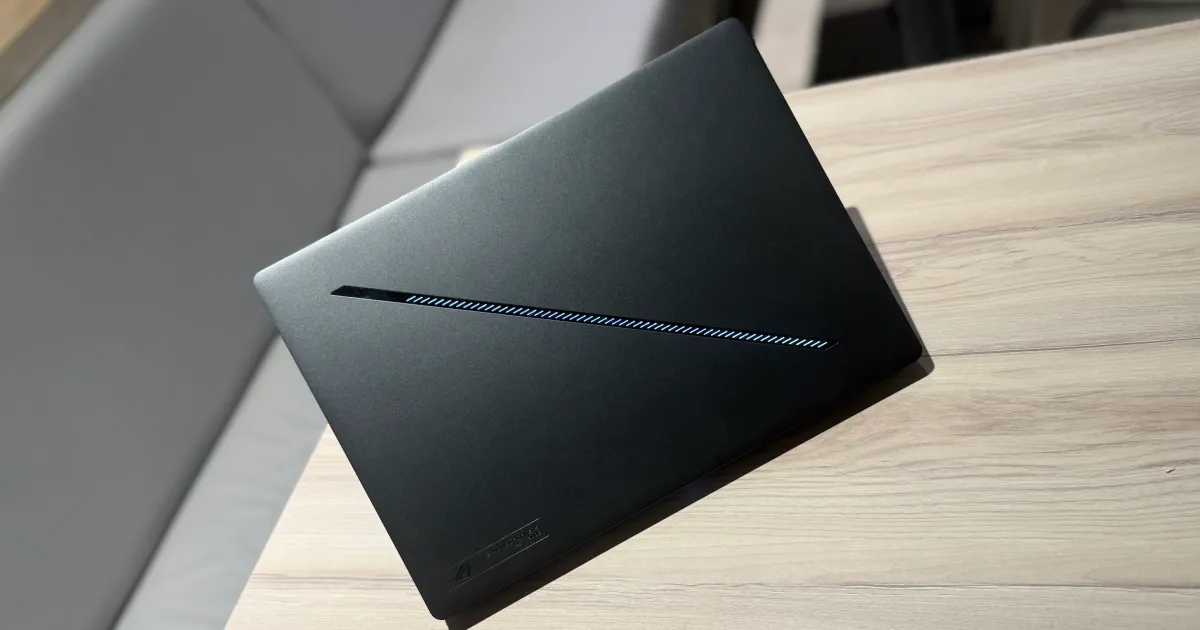
It’s no mean task to unseat the MacBook Pro. Given the current state of the flagship Apple laptop — with its fire-breathing M-series silicon, fantastic battery life, terrific trackpad, great display, and lovely build quality — its reign is rock solid. Perhaps, it will remain unbeaten for the next few years, partly because the charm of macOS will also keep buyers hooked to the MacBook Pro.
I harbored hopes that riding atop the Qualcomm Snapdragon X Elite silicon, Windows would finally deliver the knockout punch. Machines like the Dell XPS 13 came close, but didn’t quite surpass the MacBook Pro, and that brought us to square one. So, where do Windows laptops go from here?
Well, the only way forward is ahead, and that means beating the MacBook Pro. Or maybe, building upon its weaknesses. That’s where the Asus ROG Zephyrus G14 comes into the picture. This is unabashedly a gaming laptop, but somehow, it is smaller and lighter than the 14-inch MacBook Pro.
A head-turner, with practical charms
Honestly, this isn’t exactly a fair comparison. In fact, this machine is more about doing something excessive, and more importantly, what Apple’s venerable laptop can’t do. That starts with the build and looks. This is an all-metal chassis we’re looking at, made from aluminum, which is anodized, sandblasted, and polished.
The surface finish is fantastic, and what sets it apart is the fully customizable slash lighting LEDs at the back. Aside from over a dozen preset notifications, they also play to the tune of notifications. Surprisingly, this machine doesn’t scream“gamer” from a mile away, and were it not for the bulky charging brick, it would easily pass off as a productivity workhorse.
Now, here’s the big trade-off, or to put it more accurately, the occupational hazard of this machine. The RGB-backlit (and fully customizable) keyboard is made for gaming. Fittingly, the key press is a bit stiff compared to the MacBook Pro. However, I do appreciate the extra key travel on this one.
Think of this comparison as a battle between tactile satisfaction and speedy ease. The rest is business as usual, with good spacing, dedicated playback-cum-shortcut keys, and a generous trackpad underneath. But more importantly, the whole deck also plays an active role in heat dissipation.
The star of the show is the 120Hz OLED display with 3K resolution. It’s gorgeous, and in games such as Wuchang: Fallen Feathers and Tales of Kenzera: Zua, the visuals truly come to life. You also get perks such as an ultra-low 0.2ms response time, Dolby Vision, Nvidia G-Sync, and VESA Display support.
In terms of raw visual quality, the OLED panel serves its usual benefits. The color output is lovely, contrast levels are high, and viewing angles are great, too. The only problem is the glare from the glossy panel. Asus apparently went with a glossy layer to highlight the panel’s brilliance, but the light reflections prove to be a nuisance from time to time.
The 500 nits brightness doesn’t help the cause of the glare, either. The MacBook Pro’s mini-LED panel isn’t qualitatively quite as brilliant as the OLED panel on the Asus ROG Zephyrus G14, but the peak brightness of 1,000 nits negates the glare woes on the Apple laptop. To its credit, Asus has escaped the notch hell, and despite keeping slim bezels, it still managed to fit an IR sensor array for Windows Hello face unlock.
Oh, did I mention that the storage is expandable, and the port situation is more generous (and versatile) compared to the MacBook Pro? Yeah, that too!
The beast within
The biggest achievement of the ROG Zephyrus G14 is fitting an AI-ready top-shelf processor, and most importantly, a discrete graphics card in a machine of this size. At first glance, it almost seems implausible, especially when you take a peek at the thermal hardware inside this machine.
There are two heatsinks close to the rear vent, three fans, thermal paste, and a large fiber-and-mesh heatpipe. It fits a dust filter over the air intake area, too. Asus has also created a performance profile where the fans go silent, and the entire cooling is done passively, so that you aren’t bothered by the noise of the fans whirring.
All of that is impressive, but you’re buying this laptop to push the silicon inside, and that’s where it tangles in an “unstoppable forces meets an immovable object” tussle with the MacBook Pro. The AMD Ryzen AI 9 HX 370 processor at the heart of this machine isn’t quite as powerful as the M4 Pro or M4 Max at CPU workloads, but it races far ahead with its gaming chops.
Now, let’s talk performance. With a tally of 2937 (single-core) and 15707 (multi-core) on Geekbench, the AMD silicon is still 21% and 36% behind, respectively, against the Apple laptop with the M4 Pro silicon inside. The M4 Max variant further widens the multi-core performance gulf. At Cinebench 2024, the ROG Zephyus G14 was again roughly 47% and 41% behind the M4 Pro at single-core and multi-core rendering tests, respectively.
But gaming is what sets this laptop apart. The MacBook Pro is not exactly a gaming machine, but there are a few rare instances where the two laptops can be compared. Shadow of the Tomb Raider, for example, hovers in the 80-84fps range on the MacBook Pro, while the ROG Zephyrus ran at 120+ fps comfortably at the QHD+ resolution.
With ray-tracing enabled at Ultra preset in Cyberpunk 2077, I noticed a stable output of around 41-44 fps, and 63-68fps without ray-tracing at peak resolution. If you climb down to full-HD or slightly higher resolution, which is fair for the 14-inch panel on the ROG Zephyrus G14, you can easily get over 100fps with DLSS enabled. And if you are not against frame generation, set it to a factor of 4x, and the number will climb over 130fps with ray-tracing and path-tracing enabled.
This game is usually the litmus test, and the Zephyrus G14 fared pretty well, but not without the fans getting annoyingly loud at the Turbo performance preset. In the same performance state, Black Myth: Wukong stays close to 42-48fps with ray-tracing enabled at QHD+ resolution and cinematic graphics, while the combination of 4x frame generation and DLSS 4 (balanced) pushes the performance over 95fps ballpark.
Doom: The Dark Ages also plays well at the ultra graphics preset, offering a fairly stable 60fps+ output at QHD+ resolution. Forza Horizon 5 is also comfortably playable at 100fps+ at the extreme graphics tier, with DLSS and frame generation active. Overall, the golden resolution, in my opinion, is 1200p on this laptop.
Generation over generation, the performance gain over its predecessor at AAA games is roughly 30%. On a side note, the integrated Radeon 890M graphics engine is not terrible and can come in handy for casual gaming when the power brick is out of sight.
Notably, you can access the Performance mode even on battery power, just like the MacBook Pro doesn’t need to be plugged in to tap into its full potential. The turbo and manual modes, of course, would require the charging brick to manage the power draw.
The unexpected peaks, the expected pitfall
All that power, jazzy RGB effects, and OLED panel come at a cost. And in typical fashion for any gaming laptop, it is extracted from the onboard battery. Simply put, I would not recommend going out without the 200W adapter. The machine can, however, stay alive if you have a smaller charger with a minimum 100W supply over Type-C.
I wish the laptop could go higher in Power Delivery mode, hitting somewhere between 130-150W. It’s pertinent, considering the fact that you only have a 73Whr battery pack at your disposal (a hair bigger than the 14-inch MacBook Pro), and pushing it in Turbo or Manual mode drains it pretty fast. Even when handling browser-based chores in Silent or Windows modes, the battery can barely make it past four hours, despite keeping the brightness levels below the 50% mark.
With battery saver mode enabled, the battery still conked off before touching the six-hour mark. And that’s the lightest possible load scenario where I can get meaningful web-based work done. For comparison, the 14-inch MacBook Pro consistently lasted over 14 hours for my usual browser-heavy workload, with a bit of media editing thrown into the mix.
The good part is that this machine doesn’t throttle. Even on the lowest performance preset, it can blaze past tasks without breaking a sweat. In my most recent work adventure, I was running two RAM-hogging instances of an AI-heavy browser like Comet, while Chrome was also active, each with nearly a dozen tabs open, while Slack, Teams, Trello, and Spotify ran in the background. I never ran into an instance where the laptop visibly choked under load.
In a nutshell, battery life is not a strength of this machine. It would be unwise to expect otherwise from a gaming laptop. But if you want to push it as a regular laptop, you can pick a 100W PD brick that can fit in pockets and survive with it as a sweet ergonomic benefit. What this machine lacks in battery life compared to the MacBook Pro, it more than makes up for it with raw performance and an unexpected perk: AI readiness.
The onboard NPU aboard the AMD Ryzen AI 9 HX 370 processor can muster 50 AI TOPS, which qualifies it as a Copilot+ PC. That means this laptop can perform a variety of AI tasks on-device, without requiring an internet connection. Additionally, it gets access to a bunch of exclusive AI-driven features.
Chief among them is Recall, which essentially serves as a time machine for your PC and lets you visit the log at your convenience. It’s pretty nifty, even though a bit of a privacy scare. Other perks include offline transcription and translation, live captions, AI-assisted editing and generation, Click To Do, Windows Studio Effects, enhanced system-wide search, and AI-powered writing tools.
As Microsoft pushes into the AI-first software experience, pours AI smarts across Office 365 apps, and continues work on its own small language models, AI will become an even more integral part of the Windows experience in practically rewarding ways. macOS, despite its speed advantage on the MacBook Pro and fluidity, isn’t quite there yet in terms of executing meaningful AI features, especially those that run locally without an internet connection.
Let’s turn back to the Asus ROG Zephyrus G14. Does a gaming laptop need these snazzy AI features? Well, that depends on whether you’re getting the Zephyrus solely as a gaming machine, or something that dips between work and play. A healthy bunch of buyers — or at least the souls that I know — fall in the latter category, which means they will inevitably draw one or two Copilot+ benefits down the road.
A value champion with its own merits
Overall, the Asus ROG Zephyrus G14 is not just a gaming laptop. It’s an antithesis to the MacBook Pro, or a Windows antidote to folks who can’t imagine their workflow blossoming on macOS. Most importantly, this machine is about filling the gaps of Apple’s flagship (read: serious gaming).
It’s not cheap, but if you chase hardware parity in terms of RAM, storage, flexibility, and gaming chops, you will find that this $2,500 machine is more palatable than it would appear at first sight. Just to give you an idea, the 14-inch M4 MacBook Pro with 24GB (vs 32GB on the Asus laptop) and 2TB of storage will cost you $2,799 in the US.
So yeah, deciding between the two laptops is easier than it would seem. It’s a textbook case of an apples versus oranges comparison. You just have to make a pick about the right flavor.



